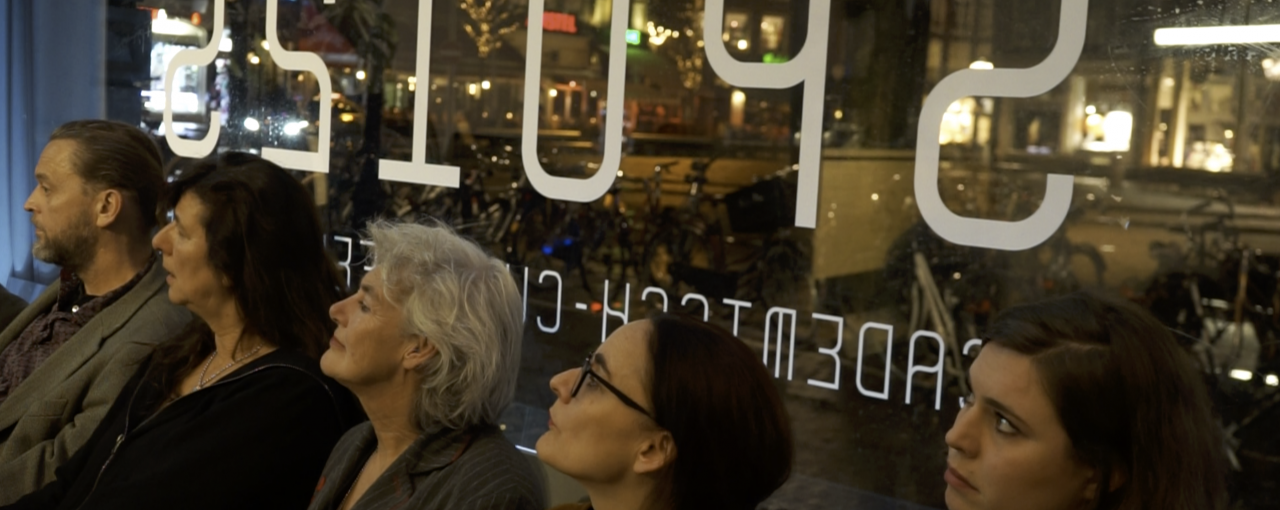At an inspirational event – beautifully titled Astronauts of the inner world – scientists and artists engage in conversation. Reason for this is the large-scale transmedial project If You Are Not There, Where Are You? in which children who suffer from absence epilepsy are matched with an artist. Scientists give advice. Art and science are important to this project in equal measure. Subject and object. The goal is to find out what happens during an absence.
A man is setting up a VR headset. Most seats in the hall have been taken. At the back wall many dark coats are hanging and a yellow one. Blurry body shapes. At the stage there is a call for attention. Around me, people quickly check their smartphones. Several are slouched over their phones. They’re not there, briefly. Half a dozen of mini absences.
The moderator starts. There are dozens of different kinds of epilepsy. When the label absence epilepsy hadn’t yet been invented, epileptics would be called dreamy or absent-minded. In the early days, they might have been perceived as divine messengers. Nowadays, medication can set a patient free from seizures. But who carries out such an attack? And where are you, when you’re not there? Witnesses say: It feels like thousands of roads run through your head. Like fear. All white. A broccoli-like substance that goes on forever.
This doesn’t clarify things for me. Recounting an experience is different from evoking one. What use is an experience – good or bad, traumatic or inspiring – if you can’t share it, because you’re lacking the proper tools? What good is the discovery of heaven, if you need to keep it to yourself? What to do when you’ve experienced something you’re sure nobody will believe? An experience that marks your life, but you cannot share it, will make you lonely.
Film academic Patricia Pisters and neurologist Steven Claus de Jonge are talking.
Perception is an amazing thing, says Patricia. Only when you want to leave the room, you’ll notice the door handle.
In our daily language we act as if perception is only passive, but it is also creative. The late neurologist and author Oliver Sacks was crystal clear about this. Every observation influences our neurons. By seeing, we change the structure of our brain and the way we experience the world. Maartje Nevejan, initiator of the project, talked with Sacks.
I’m convinced it’s the stuff that fairy tales are made of, he said about absences. And so we end up in the literary domain. Finally I understand this: A writer is a journalist of the inner world.
I would love to hear more from Pisters and De Jonge, but it is time for a break. The smartphones light up again. Everybody is busy sharing things all day long, mostly trivialities, rarely the important stuff. The things that control our lives, that we might want to share the most, we don’t know how to share those. They don’t fit in a status update; we lack the proper vocabulary.
We need to look for a new language, many say during the evening. Imagine you’d find one. A new language. A couple of aliens land their pickle-shaped spaceships on earth and they teach you their language as a gift, after which they take off again. I’m not making this up, it comes from a film. You would be the only one in this world who masters this foreign language. You’ll gain a unique insight. But it is only you. What do you do with that?
People, who claim to look for a new language, mean: images. The astronauts of the inner world make me understand that children with absence epilepsy will become less fearful of their disorder by working with an artist. That helps.
A film, a VR setup or a poem can leave space to the imagination and can communicate fantasy or visions. An inner image from a dream world, the underworld or a fairy tale world – simply because you can see it – can change something in your brain. Status update: By seeing you can change the world around you.
